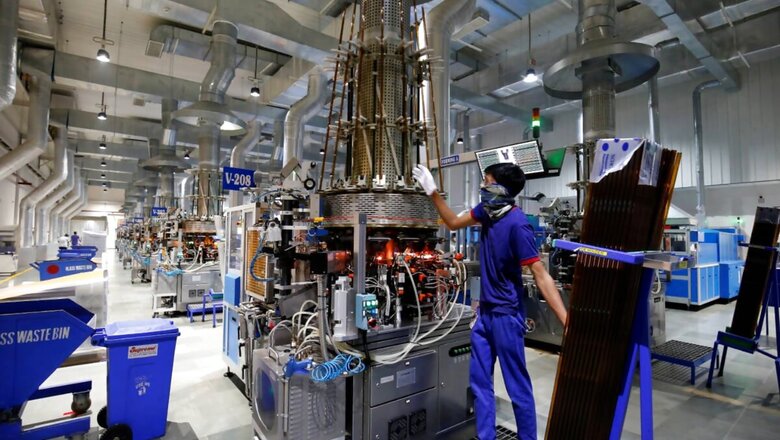
views
It is a ‘V’. The government has once again described India’s economic recovery in alphabetical terms and given itself another pat on the back for adequate fiscal response to the pandemic-induced economic shock in 2020. It has referred to “myriad” fiscal stimulus measures and declining daily infections to say that the Indian economy is riding against the global Covid-19 wave.
But this optimism and self-congratulation are premature since sustained economic recovery is still far away, the improvements are not all broad-based and improving sequentially does not mean we have reached pre-Covid levels. The Indian economy is not out of the woods yet.
As per government data, GDP contraction in the June quarter (April-June) was the worst ever at -23.9% but the contraction had eased significantly by the next quarter to just -7.5% between July and September. Two consecutive contractions meant India slipped into a technical recession for the first time ever. The country is widely expected to improve the growth figure in the December quarter and some economists have said earlier that the March quarter could actually see a low positive growth number. But the country is still expected to close the year with a negative as far as GDP growth is concerned.
So it is worth noting that in the monthly assessment for December, the finance ministry has spoken of a sharp, “V-shaped” recovery in the economy since June and predicted that economic growth in the second half of the fiscal year would be much better than in the first half. The only downside risks it has alluded to are the general fatigue from social distancing norms and the new, more virulent virus strain found in the UK which is more contagious.
While there can be no gainsaying the fact that key economic indicators have improved in the last few weeks, this improvement is neither broad-based nor has India outpaced other emerging markets in recovery. Our factories are still running below capacity, inflation concerns continue and the outside of the agriculture sector, growth has been patchy.
The finance ministry has cited a record GST collection figure for November (collected in December), comfortable liquidity situation, improved credit growth, current account surplus and improved numbers for railway freight and port traffic to buttress its claim of a V-shaped recovery.
But a Mumbai-based brokerage pointed out that though the all-time high GST collection figure of Rs 1.15 lakh crore was partly due to improving economic activity, improved festive demand and better compliance under the GST regime also played a role. Thus, it is best to remain cautious over this trend of record collections sustaining in the coming months as festive demand fades. In any case, overall GST receipts may still be short of last year’s collection by nearly Rs 1.6 lakh crore by the end of the fiscal.
Another brokerage, Edelweiss, has pointed out that India’s recovery has lagged behind that of other emerging markets. It has also said that large Indian companies – the formal sector – have gained market share in most sectors from the informal sector since March. So the recovery in corporate profits and sales in some sectors remains a case of unequal recovery, with smaller companies continuing to suffer.
In India, a vast majority of employment (four in five people work in the informal sector) and production happens in the informal sector but official data does not cover the entirety of the informal sector activity and whatever is covered is done through proxies, with a lag. In other words, data on factory production, employment etc. which have shown an uptick in recent months reflect the resurgence of large companies, without taking into account the devastation happening across the informal sector.
Edelweiss has also shown that the current phenomenon – where listed companies in each sector have seen growth return at a much faster pace than unlisted ones – is similar to the trend seen during demonetisation (2016-17 and 2017-18).
As for the core sector, recovery seems to be largely missing.
Mounting concern that recovery of Core Sector patchy. (Core = Steel, Cement ,Crude , NatGas ,Refinery prods, Fert, Coal & Elec). Nov 9th straight month of ↘️. Steel & cement ( indicators of capex revival ) had Nov growth of -4.5 & -7 % . Shovel- ready public projects needed !— Vinayak Chatterjee (@Infra_VinayakCh) January 6, 2021
Vinayak Chatterjee, chairman of the Feedback Infra Group, has pointed to mounting concern over core sector recovery, calling it “patchy”. The core sector comprises steel, cement, crude oil, natural gas, fertilisers, coal and electricity production. Chatterjee has noted that November was the ninth straight month of a decline in steel and cement production (year on year) and this showed capex revival was not happening. “Shovel-ready public projects needed!” he said.
Ratings agency ICRA has differentiated between the services sector and others to say that “contact intensive” parts of the economy will continue to lag the rest of the economy in growth this year. And large companies in each sector will gain further market share at the cost of smaller ones. “Overall, capacity utilisation may remain below pre-Covid levels this fiscal… improvement in business sentiment and the confidence to undertake capacity expansion may be uneven over the next several quarters.”
All eyes are now on the Union Budget, scheduled for February 1, for a roadmap on government spending and additional measures to spur growth in FY22. The World Bank said earlier this week that the Indian economy is still expected to contract by 9.6% this fiscal and this was due to a sharp drop in household spending and private investment. The informal sector, which accounts for four-fifths of employment, has also been subject to severe income losses during the pandemic but the World Bank noted that recent high frequency data indicate that the services and manufacturing recovery is gaining momentum.
Read all the Latest News, Breaking News and Coronavirus News here




















Comments
0 comment